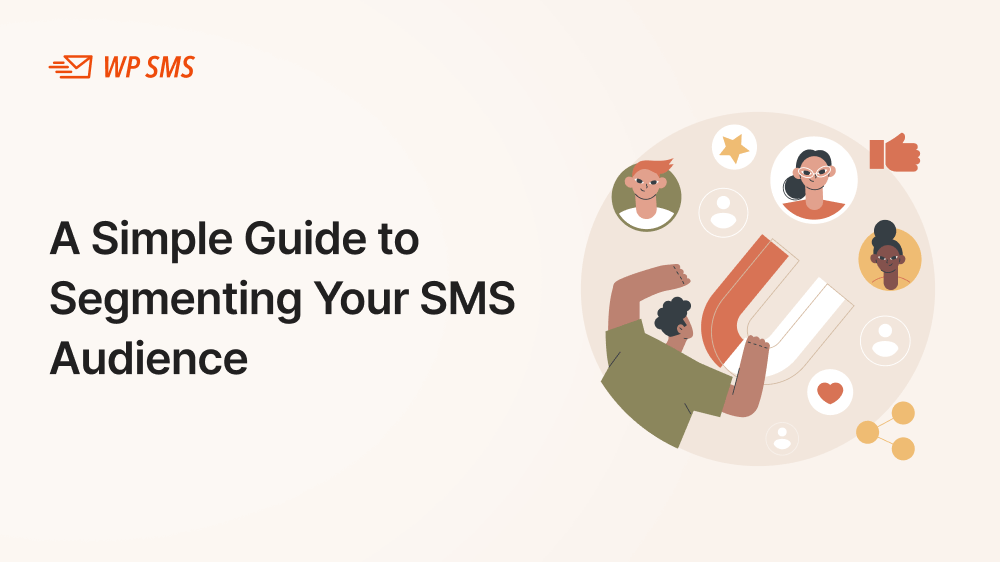Do you use SMS marketing segmentation? If not, you’re making a great mistake!
Without segmenting your SMS recipients, you can’t run an efficient marketing campaign. The reason is that if you send a single SMS to all people, you’ll ignore their differences and the engagement rates will definitely be lower than your expectation.
In this blog post, we’re going to explain why you have to segment your SMS marketing audience and how to do that.
If you need more info about segmenting your audience using WP SMS, you can contact us or try our demo.
What Is SMS Audience Segmentation?
SMS audience segmentation simply means you divide your subscribers into several groups and talk to each group differently.
The reason is that each group has a specific characteristic that causes different interactions with certain text messages and offers.
For example, imagine you’re sending a text message to offer a discount on your clothes. Of course, if you divide your subscribers based on their gender and age, you can target them better and offer more relevant products.
In sum, the goal of segmenting the recipients of SMS marketing is to send more personalized and relevant SMS messages. The expected result is also higher engagement rates.
Here are some of the benefits of SMS segmentation:
- Improving the relevance of your messaging
- Increasing engagement rates (opens, clicks, and conversions)
- Reducing unsubscribes
- Enhancing customer experience
- Boosting overall ROI of SMS marketing
Types of SMS Marketing Segmentation
You need to consider several factors to segment your SMS audience. Below are some of the most effective SMS segmentation strategies:
Demographic Segmentation
Demographics are statistics that describe people by their characteristics like:
- Age
- Gender
- Income level
- Occupation
In fact, demographic factors define your audience based on their personal aspects. Segmenting your audience based on these personal factors lets you generate more personalized text messages that are highly likely to attract potential customers.
Here are two SMS examples of demographic segmentation:
- SMS Example 1: Targeting Women in Their 20s
Message
- SMS Example 2: Targeting Women in Their 50s
Message
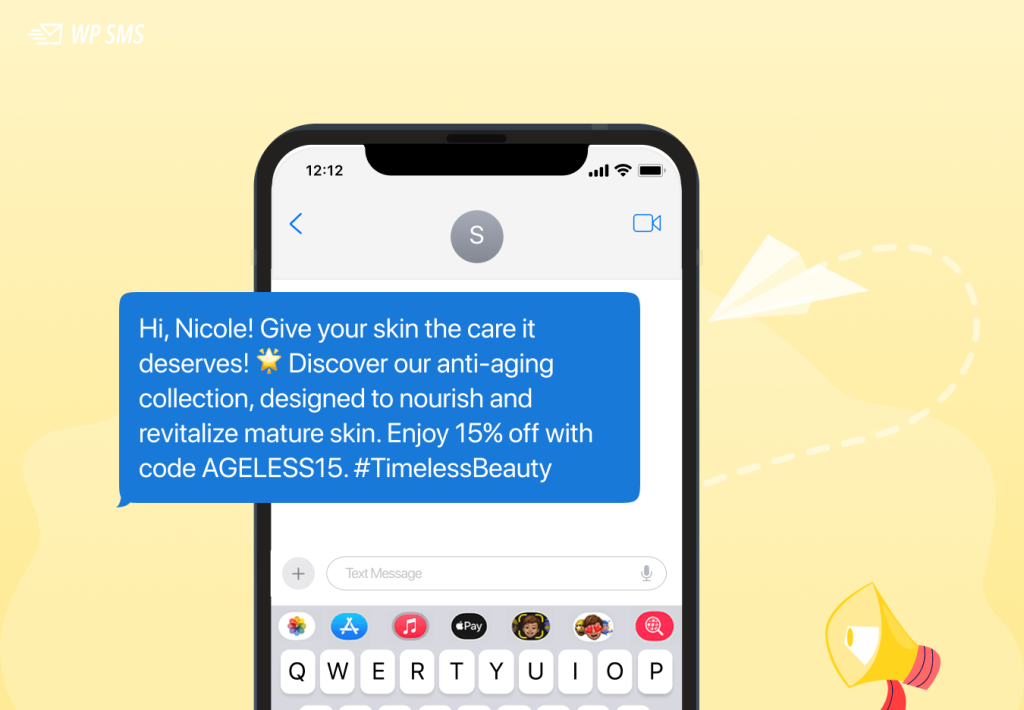
As you see, both SMSs are promoting a skincare product but in two different languages. Pay attention to the words and tone of voice that have been used to talk to young and old ladies.
This segmentation helps you gain the trust of your audience because they see you’re specifically talking about their problems.
Geographic Segmentation
As it comes from the name, geographic segmentation divides your audience by their location.
In fact, you send SMS to people in a specific region because other people are less likely to interact with it. There are many situations in which you need to use geographic segmentation for your SMS marketing campaigns. Here are some reasons why we need segmentation based on location:
- Localized Offers and Promotions
- Weather and Season-Related Campaigns
- Cost Efficiency
- Better Event Promotions
- Adapting to Regional Preferences
For example, if you have a restaurant and you want to promote a special lunch, you’d better send a text message to people within a 5-mile radius of your place. Otherwise, you’ll probably face a low engagement rate.
Behavioral Segmentation
Previous interactions with your customers are also an important factor in the segmentation of your SMS campaigns.
In fact, you’ve to distinguish those who’ve bought something from you from potential customers who have not become your customers yet.
Also, you can divide them based on what they’ve bought, their comments, their level of satisfaction, and even their searches on your website.
For example, customers who frequently check your products or click on your promotional SMS messages deserve an exclusive VIP offer. On the other hand, you can send welcome messages to people who are not interested in your products.
Take a look at the following sample messages to understand the importance of behavioral segmentation:
- SMS Example 1: For Customers Who Frequently Interact
Message
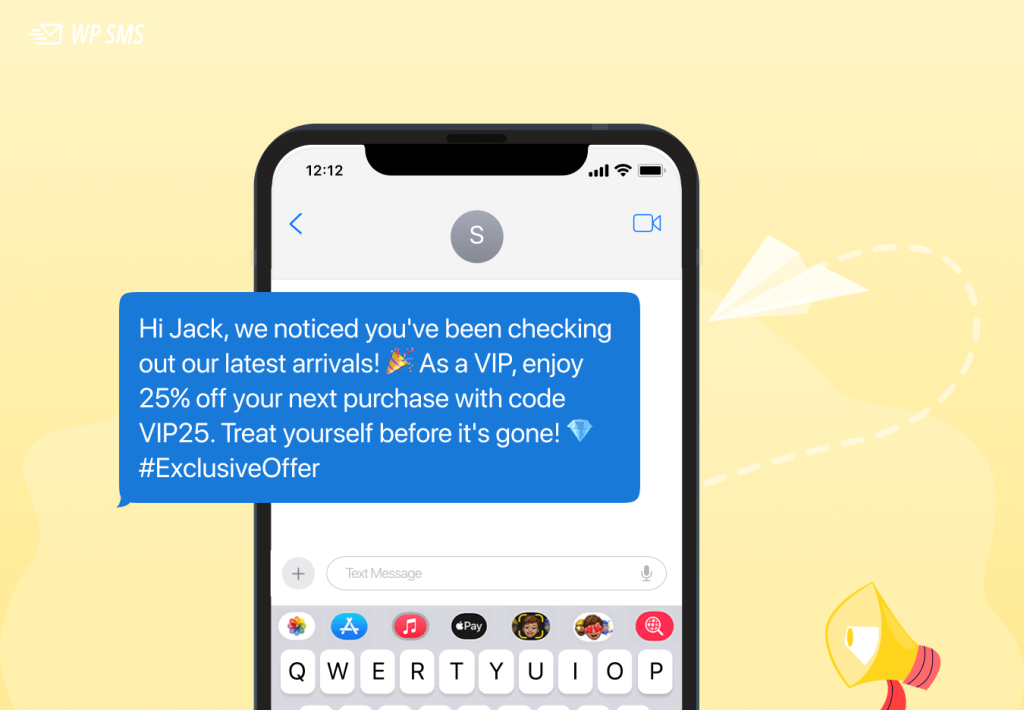
- SMS Example 2: For Potential Customers Who Haven’t Purchased
Message
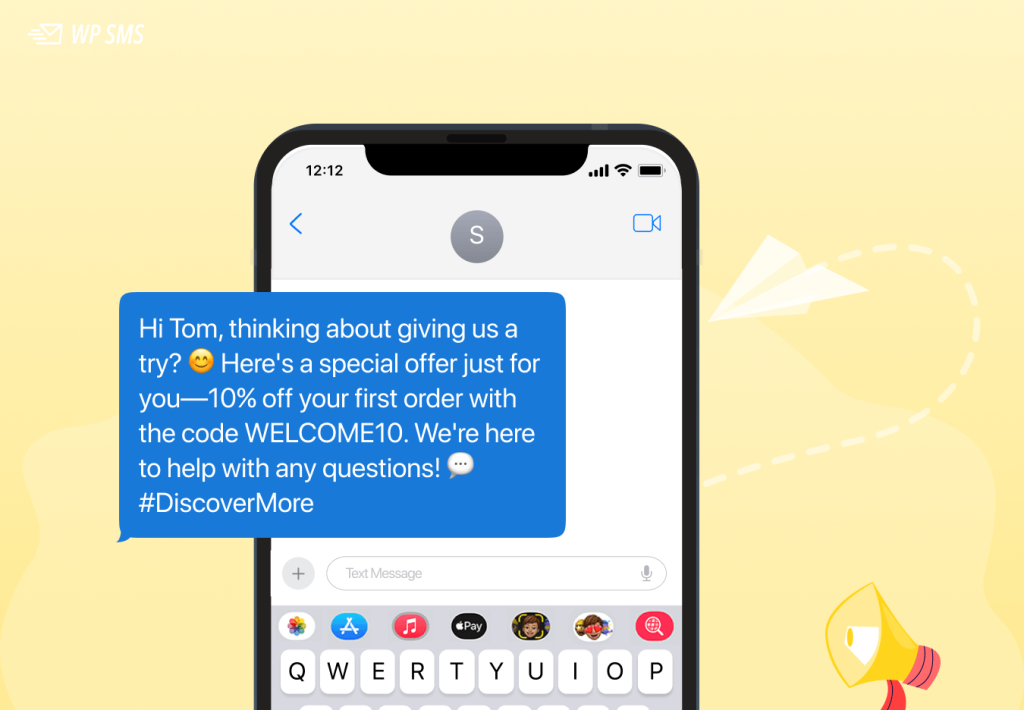
Segmentation Based on Loyalty
People engage with your brand at different levels. Some of them might be highly engaged, while others may have gone silent.
You can segment them based on their engagement level and their loyalty to your brand. For example, those who click on your ads, comment on your social posts and repeat their purchases are loyal to your brand and deserve a different offer in your SMS marketing campaign.
Here are two SMS examples for this kind of segmentation:
- SMS Example 1: Loyal Customer (Highly Engaged)
Message
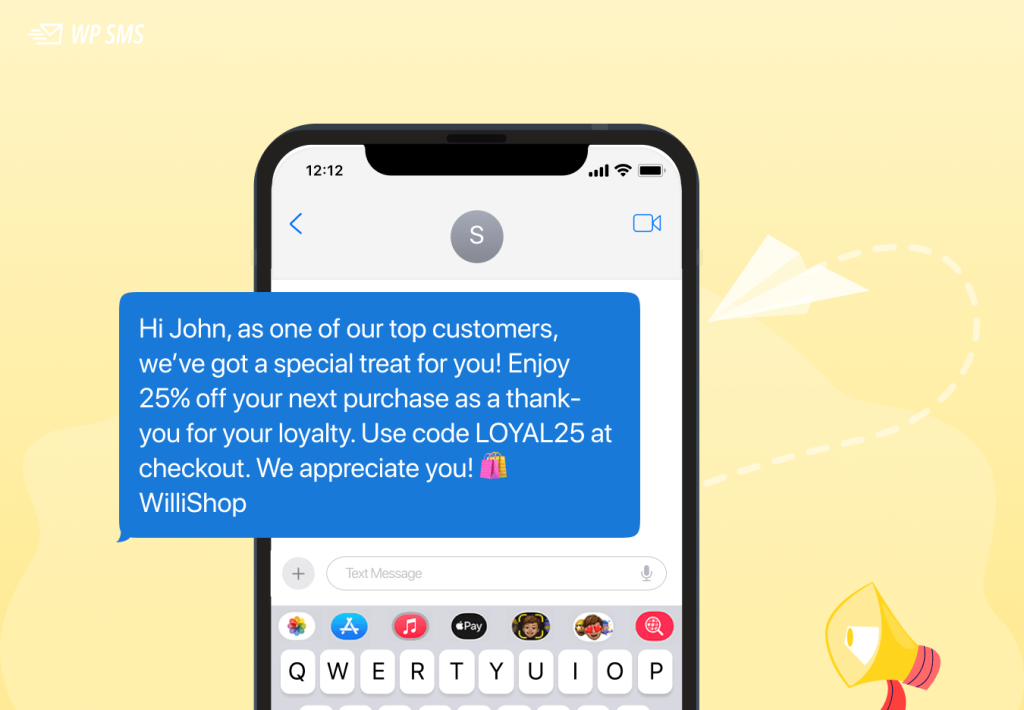
- SMS Example 2: Low Engagement
Message
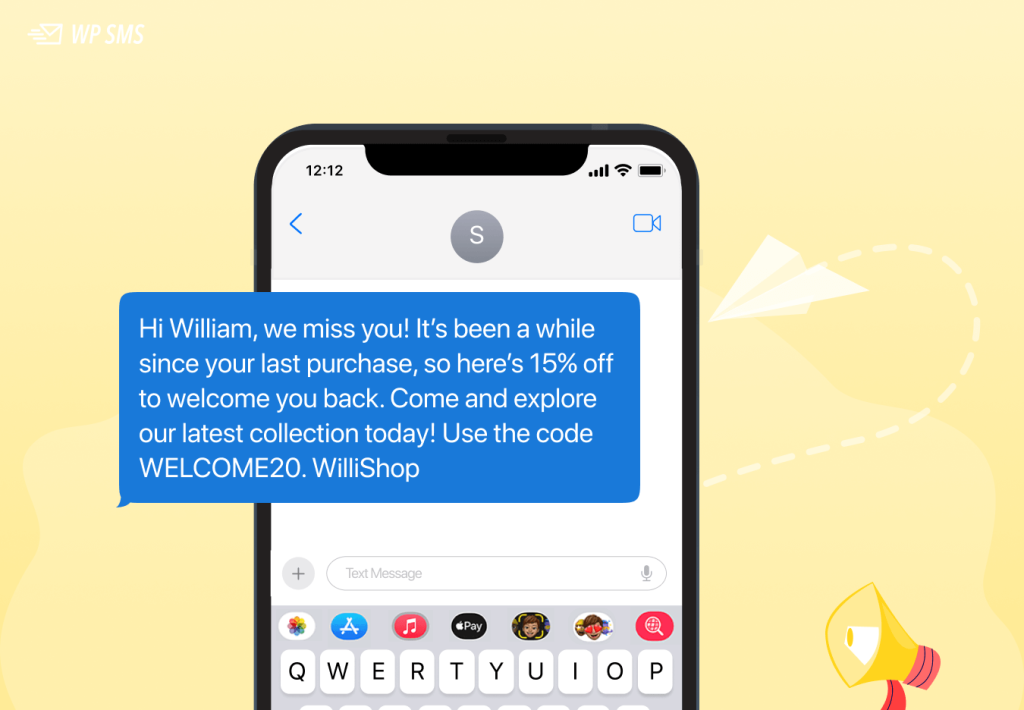
Steps to Segment Your SMS Audience
Here, we want to present a systematic approach to simply the process of segmenting your SMS marketing audience.
Step 1: Understand Your Audience
The first and most important stage in segmenting your audiences is gathering data about them.
If you don’t know your potential customers well, you can’t divide them correctly. The data can include demographic information, purchase history, interaction with past campaigns, and other insights.
You’d better gather as much info as possible considering the customer consent and your compliance with regulations like GDPR and TCPA.
Users might have to use analytics tools, surveys, and competitor research data to gain a deeper understanding of your audience. Try to consider all of your customers’ needs, and preferences before segmenting your audience.
Step 2: Define Your Segmentation Criteria
Next, you have to decide how you want to segment your audience. Here are some tips and examples to define your criteria to segment your audience:
- Engagement Level: If you want to promote your customer loyalty program, you’d better consider your audiences’ engagement level to segment them.
For example, you can divide them into frequent buyers, occasional shoppers, and inactive customers.
- Demographic: Imagine you’re launching a new product line for a specific age group. You have to use demographic segmentation to target customers within the suitable age group.
- Purchase Behavior: Many times you have to consider the previous choices of your customers. For example, for seasonal sales, you could segment your customers based on what they purchased last year.
Step 3: Use the Right SMS Marketing Tool to Create Segments
WP SMS is a great WordPress plugin that lets you use your website’s users to create segments and send automated and scheduled messages as well as bulk text messages.
This plugin supports more than 300 SMS gateways and has some advanced features and add-ons like:
- Bitly Short URL
- Newsletter
- Automation
- Scheduling
- 2-Factor Authentication SMS
- WooCommerce Mobile Verification
- Zapier Compatibility
Step 4: Create Text Messages for Each Segment
Once you have your audience segments, it’s time to create messages specifically for each group.
You have to pay special attention to the tone, content, and call-to-action of your message. These factors should be written according to the preferences of the specific audience segment.
As you know, SMS has a limitation of 160 characters so you have to include all of these items in a concise yet impactful message.
Step 5: Test and Optimize
Your task isn’t finished after sending it text messages. You have to track your campaign to see if your segmentation is performing well.
To analyze your SMS segmentation, you can run an A/B test to check the results of two versions of your segmentation. This way, you can see the best SMS marketing segmentation for your future campaigns.
Best Practices for Effective SMS Marketing Segmentation
Here are some tips to get the most out of your SMS segmentation efforts:
1. Keep It Simple
Avoid complicating your segmentation. Try to start with a simple segmentation and expand it over time. The more you engage with your audience, the better you can segment your audience.
2. Respect Personal Data Protection
You can’t use your audience data without their consent. Try to get consent clearly and make sure they know why you’re using their data.
3. Set SMART Goals
You need to define specific, measurable, achievable, realistic, and time-bound goals. Each SMS message segment should be based on a clear goal. Having a clear goal helps you create more effective messages.
4. Send Your Messages At the Best Time
You can’t send you messages whenever you want. There is no certain formula to determine the best time to send SMS but overall, you can count peak hours like:
- Thursday at 2 p.m.
- Friday at noon
- Saturday at 7 p.m.
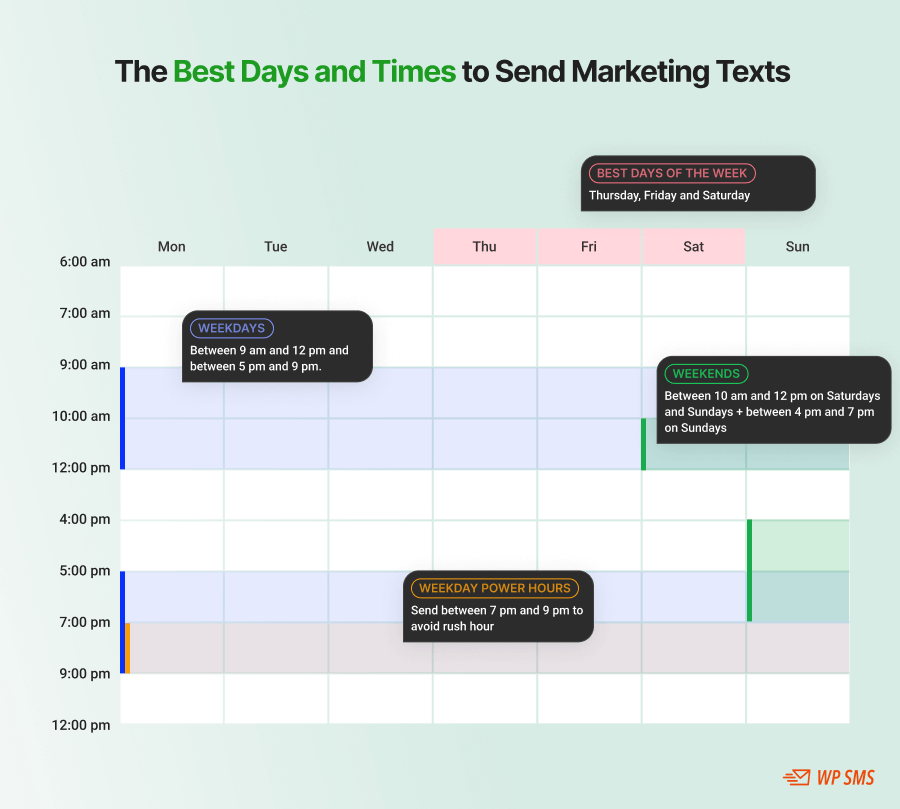
Common Mistakes in Segmenting SMS Audiences
Last but not least, you have to avoid some mistakes when segmenting your audience for your SMS marketing campaign:
- Don’t push too hard for it: Make sure you’re using a segment large enough to have a considerable number of audiences.
- Avoid outdated data: This is an ever-changing field so oyu have to update your data regularly.
- Avoid generic messages: Using the same message across different segments will cancel out the effect of segmentation. So try to work hard on the content.
Final Thoughts
SMS marketing segmentation can lead to higher engagement rates and boost your sales. You need to divide your audiences into various groups and talk to them considering their specific characteristics. This way, they feel you’re paying attention to their needs and trust in your brand.
The key to a successful SMS audience segmentation is using the right tool. WP SMS is one of the best WordPress SMS plugins that integrate into your website and can segment your website’s users. You can try our demo for free if you need more information.
FAQs
How does SMS audience segmentation work?
Audience segmentation means you divide your customers into various groups based on important factors like behavior, preferences, or demographics. The main purpose of SMS marketing segmentation is to send laser-targeted and personalized marketing messages and get higher engagement rates.
How does SMS marketing affect consumer behavior?
SMS marketing has a higher open rate compared to other marketing channels. It encourages people to take quick action and is best for time-sensitive events.
How to segment our SMS marketing audience?
First, you need to choose the right tool. WP SMS is a great choice because it allows you to segment your website’s users based on factors you like. Then, you have to divide your subscribers based on important factors like age, gender, or previous purchases. After that, you have to create specific SMS content for each group.
